About Matt
Matt George is the co-founder and CEO of Merlin Labs, a company focused on autonomous aviation systems for both military and commercial applications. Prior to founding Merlin, Matt built and sold another transportation company that gave him deep insight into the challenges of autonomy in ground-based systems. This experience provided him with a unique perspective on the relative advantages of addressing autonomy in the air versus on the ground.
A licensed pilot himself, Matt brings both practical aviation knowledge and entrepreneurial experience to Merlin Labs. Matt designed Merlin's strategy around military customers from day one, viewing them as essential early adopters for autonomous flight technology.
About Merlin Labs
Founded to develop autonomous flight technology for existing aircraft, Merlin Labs is taking a fundamentally different approach to the challenge than many competitors. While most autonomous systems try to augment human pilots, creating a potentially dangerous shared control situation, Merlin's system operates as the primary pilot with human supervision. The "Merlin Pilot" is responsible for flying the aircraft, communicating with air traffic control, and making operational decisions, with a human supervisor available to take control if necessary.
Merlin's technical approach focuses on mastering the fundamentals of autonomous flight rather than focusing immediately on advanced capabilities. As Matt explains, the actual difficult part of transitioning to autonomous aviation is "reliably flying airplanes with a fully onboard non-human pilot" — the basic functions that human pilots perform day in and day out. Once this foundation is established, more advanced capabilities like formation flying or complex mission profiles can be added as "apps" on top of the core system.
The company began with simple experimental aircraft, progressing to increasingly complex military platforms. Their approach has garnered significant traction with military customers, beginning with Air Force Special Operations Command (AFSOC) and expanding to Air Mobility Command (AMC) and Air Combat Command (ACC). Merlin has moved rapidly from Small Business Innovation Research (SBIR) contracts to Other Transaction Authority (OTA) agreements and now to a nine-figure production contract, with tens of millions of dollars already being executed against it.
Merlin's strategy involves dual certification paths, working with both military and civilian regulators to certify their core autonomous pilot system. Once certified, this core capability can be adapted to specific aircraft with only incremental certification work required. This approach has recently yielded a significant milestone: the first approved airworthiness plan for integrating autonomy onto a mainline Air Force aircraft.
Key Takeaways
Autonomy with Human Supervision: By designing their system to operate as the primary pilot with human supervision—rather than as an assistant to a human pilot—Merlin addressed a fundamental safety challenge in aviation autonomy. As Matt explains, "When you try to get computer systems to help humans as a step towards autonomy... that's where you get bad stuff." Many aviation accidents occur when humans and automated systems fight for control of an aircraft. By establishing clear lines of authority, with the autonomous system in control and a human available to take over if needed, Merlin creates a safer transition path to full autonomy.
The Power of "D-Minus Work": Many defense tech startups spend years developing an "exquisite" product before approaching customers, only to discover they've built something that doesn't address actual user needs. Matt took the opposite approach, advocating for showing customers early prototypes—what he calls "D-minus work"—to gather feedback and build relationships. Merlin's first demonstrations involved simple canard pusher airplanes purchased for a few thousand dollars, with basic computers literally cooled by duct-taped dry ice. By bringing military customers to see these early demonstrations and even fly in the experimental aircraft, they built credibility and shaped their development roadmap based on real user feedback.
Military-First Go-to-Market Strategy: Contrary to the conventional wisdom that commercial markets offer faster paths to revenue, Merlin deliberately targeted military customers first. Matt recognized that autonomous flight faces significant regulatory hurdles in the commercial sector: "A lot of companies that started out in the aviation space dramatically underestimated the bureaucracy of the civilian regulator." By focusing initially on military applications, Merlin could generate meaningful revenue and operational experience while building toward eventual commercial deployment. This strategy paid off dramatically when Matt made a memorable bet with investor Josh Kopelman, wagering his right kidney that Merlin would generate one million dollars in defense revenue before the end of their seed stage—a bet he won.
The Hidden Challenges of Aviation Autonomy: The real technical challenge of autonomy is in mastering the basics: "the actual difficult part is the unsexy stuff of reliably flying airplanes." By focusing on building a robust foundation for everyday flight operations, Merlin created a platform that can be progressively enhanced with more advanced capabilities. This insight guided their technical development roadmap away from flashy demonstrations toward reliable core functionality.
The Coming Defense Tech Consolidation: Matt's most sobering insight is around defense tech math. Looking at companies that have raised more than $10 million in venture funding, he observes that their collective projections would "require the DoD to 10x over 36 months the amount of money spent on non-traditional companies" from roughly 1% to 10% of the defense budget. Since this dramatic shift is unlikely, Matt predicts "a washout of a bunch of defense tech startups." This may take the form of defense primes acquiring innovative startups and potentially a private equity-backed "roll-up vehicle" that could aggregate point solutions before approaching larger defense tech companies. Rather than viewing this consolidation as a failure, Matt sees it as a natural and healthy evolution: "Building capability for the mission is what matters here. Great financial outcomes are an enabler of that."
For more on Merlin: https://merlinlabs.com/

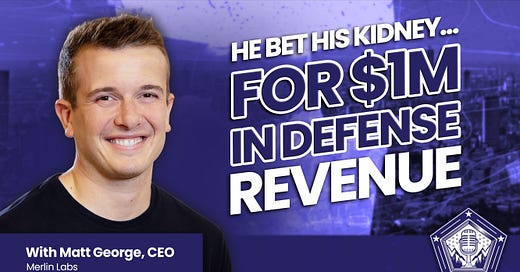
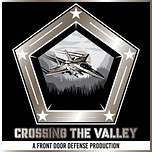


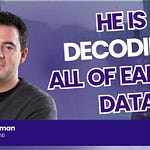
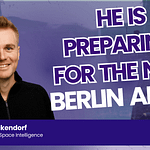

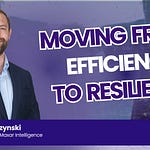


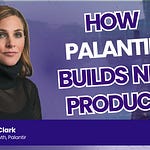
Share this post